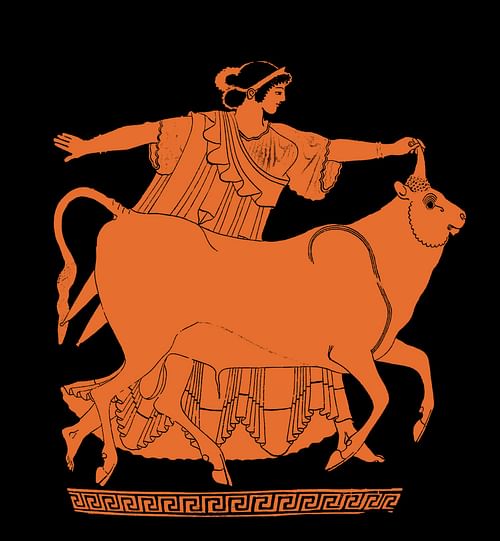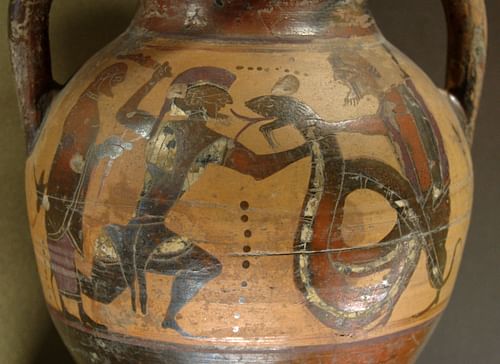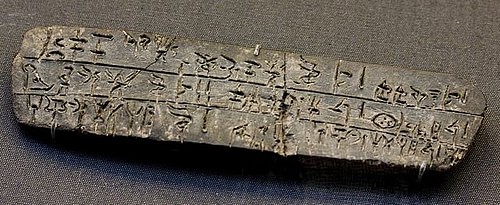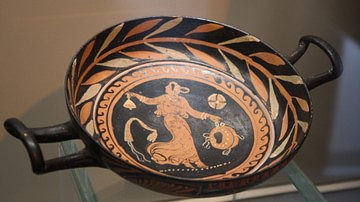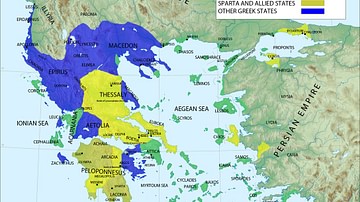
Cadmus is a Phoenician-born prince and the founder and king of Thebes in Boeotia in Greek mythology. He travelled to Greece from his home in Tyre in search of his sister Europa who had been kidnapped by Zeus. His rescue mission was abandoned after the Delphic Oracle informed him that his destiny would be to found a city.
Cadmus faced a dragon and served eight years as a servant to Ares before he founded Thebes. He is considered one of the first great heroes in Greek mythology, alongside Hercules, Perseus, and Bellerophon. He was also credited with bringing the alphabet to the Greeks.
Family
Cadmus is the son of King Agenor and Queen Telephassa of Tyre and the brother of Europa, Phoenix, and Cilix. He married Harmonia, the daughter of Ares and Aphrodite, and together they had five children.
To Cadmus, golden Aphrodite's child
Harmonia was married and she bore
Ino and Semele, and the fair-cheeked
Agave, and Autonoe, the wife
Of Aristaeus with the flowing hair,
And Polydorus, in high-towered Thebes.
Although Cadmus and Harmonia had divine ancestry and were loved by the gods, their descendants were cursed, with lives that were defined by violence and death.
Cadmus' Travels
Zeus was in love with Europa, and disguised himself as a white bull, luring her away from her family and kidnapping her. King Agenor sent his sons to rescue their sister and ordered them not to return without her; otherwise, they would be exiled. Cadmus and his brothers travelled far and wide, searching for their sister, but were unsuccessful in locating her or were unwilling to cross Zeus. They each settled in other lands, fearing the anger of their father.
During his search for Europa, Cadmus travelled with his mother to Rhodes, where he built a temple dedicated to Poseidon and another one in Thera. Herodotus (c. 484-425/413 BCE) claimed that Cadmus left some Phoenicians on the island of Thera, where they remained for eight generations. They also visited Thrace, where Telephassa fell ill and died.
Cadmus & the Delphic Oracle
After laying his mother to rest in Thrace, Cadmus decided to seek the wisdom of the Delphic Oracle.
At last he visited Delphi,
and kneeling down he questioned the god:
'What land must I live in?'
Phoebus replied, 'If you make for the wilds,
you will soon be met
by a cow that has never been yoked or harnessed
to draw a ploughshare.
She is to guide your path, and where she settles for grazing,
found a city with walls and name the region Boeótia.'(Ovid, Metamorphoses, 3.7-13)
Cadmus travelled to Phocis, where King Pelagon sold him a cow with moon-shaped markings on its body. He and his companions followed it closely until it grew exhausted and lay down. Cadmus knew that this was the site of the city he would build. He decided to sacrifice the cow to Athena and sent his men to gather water from the Spring of Ares, unaware that it was guarded by a fierce dragon.
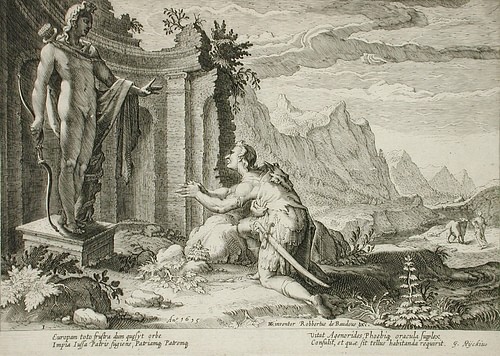
The Dragon & the Spartoi
The dragon attacked and was killed by Cadmus. After sacrificing the cow, Athena appeared to him and instructed him to bury the dragon's teeth in the soil. He obeyed her orders, and armed men known as the Spartoi sprung from the ground and began fighting each other. Some sources say that it was Cadmus who made them fight by throwing a stone at them. Once the battle ended, there were only five Spartoi left standing. They were known as Chthonius, Hyperenor, Pelorus, Udaeus, and the greatest of them all, Echion, whom Cadmus gave to his daughter Agave in marriage.
The dragon was sacred to Ares, and he ordered Cadmus to be his servant for a 'great year' (believed to be eight years) in penance.
Marriage to Harmonia
After Cadmus was freed by Ares, he and the surviving Spartoi built a great citadel or acropolis, which was named Cadmeia after Cadmus. The walls of Thebes were built up around the citadel. After Thebes had been established, he married Harmonia, with some traditions saying that she was given to him by the gods. Their marriage was believed to have been a symbolic coupling of the Eastern (Phoenician) and Western (Greek) worlds.
Their wedding took place at Thebes and was a grand affair. It was the first wedding of mortals that the 12 Olympian gods all attended. In their honour, Cadmus had twelve golden thrones set up for them. The Muses entertained the guests with music, and all the gods brought gifts for the couple, including Aphrodite, who gave her daughter the golden necklace that would become known as the Necklace of Harmonia in Greek mythology and which bought bad luck to all who wore it, although other traditions state that Cadmus himself gave the necklace to his wife.
According to Pausanias (c. 115 to c. 180 CE) in his Description of Greece, the ruins of the house of Cadmus, where the wedding took place, could still be seen in the marketplace of Thebes. Cadmus and Harmonia had four daughters, Semele, Ino, Autonoë, and Agave, and a son called Polydorus.
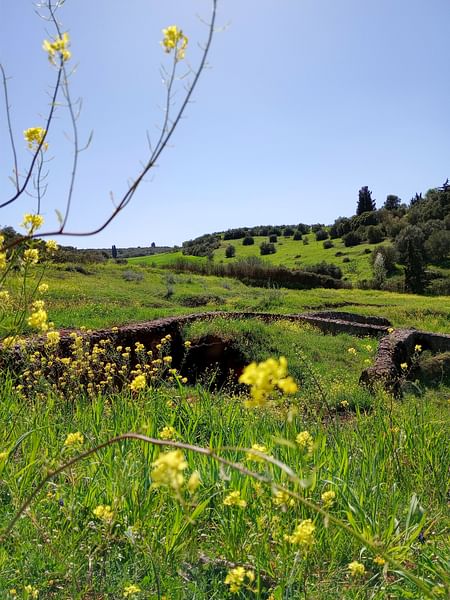
Later Life
Some traditions state that Cadmus locked his daughter Semele and her newborn son Dionysos in a chest and set them out to sea to die. Dionysos was then brought up by Semele's sister Ino who was then driven to madness by Hera. Growing increasingly disillusioned, and with his city being embroiled in civil unrest, Cadmus blamed the death of the sacred dragon for his family's bad luck. He abdicated, and either his son Polydorus or his grandson Pentheus became king of Thebes in his place.
After the violent death of their grandchildren and daughter Ino, Cadmus and Harmonia travelled to Illyria, where he helped the Echeleans fight. Some sources state that he later founded the cities of Lychnidos and Bouthoe and became their king. One day he spoke aloud and said that if the gods were so worried about the life of a serpent, then he would like to become a serpent himself. His body immediately began to grow scales and change its form. Upon seeing her husband's transformation, Harmonia prayed to the gods that she would join her husband, and they granted her her wish.
In other traditions, Cadmus and Harmonia were transformed into serpents after their deaths, and the serpents watched over their tombs while their souls were sent to the Elysian Fields. In Euripides' (c. 484-407 BCE) Greek tragedy, the Bacchae, Dionysos tells Cadmus that both he and Harmonia will be turned into serpents before being brought to live in the Isles of the Blest.
You will become a serpent, and your wife
will also change her shape and be a snake,
your wife Harmonia, human child of Ares.
And as the prophecy of Zeus foretold,
you and your wife will drive an oxcart, leading
tribes of barbarians. With your vast army
you'll sack a set of cities. But when they
reach Delphi, they are doomed: no journey home!
But Ares will protect you and Harmonia,
and make you live forever with the gods.(Euripides, Bacchae, 1130-1339)
The Alphabet
According to Herodotus in his Histories, and other ancient authors, the early Greek alphabet was derived from the Phoenician alphabet, and Cadmus is said to have introduced this alphabet to the ancient Greek world around the 8th century BCE. Although Cadmus changed the order of the letters, he kept alpha as the first letter because the Phoenician aleph means an ox and Boeotia was the land of the oxen. Herodotus wrote that he had seen this alphabet (mentioned as Cadmean writing) in the Temple of Apollo at Thebes. The Greeks further adapted the alphabet by adding vowels and changing the shapes of some of the letters.
Some scholars believe that the legend of Cadmus introducing the alphabet to the Greek world reflects older traditions about the origins of Linear B writing in ancient Greece. The Phoenician alphabet was believed to have been younger than Thebes itself, and the ancient Greeks already had the Linear B writing system, which was derived from the Linear A writing system that originated from the Minoans. This is further evidenced by the number of Linear B tablets that have been excavated in Thebes.
Origins of Cadmus
Over the years, there has been some debate about the true origins of Cadmus. Some scholars believe that Cadmus was originally a Boeotian and that it was only in later times that Cadmus became a traveller from Phoenicia who introduced the Phoenician alphabet to the Greeks.
In his Description of Greece, Pausanias mentioned that some people even believed Cadmus originally came from Egypt. However, Pausanias disputed this by saying that the statue of Athena, which was dedicated by Cadmus, was originally named Onga – the Phoenician name for Athena.
Worship & Legacy
As mentioned in Pausanias' Description of Greece, in Sparta, there is a painted meeting house with a shrine dedicated to the divine hero Cadmus located next to it. In modern-day Lebanon, Cadmus is still celebrated as being the 'carrier of the letter' to the world.

